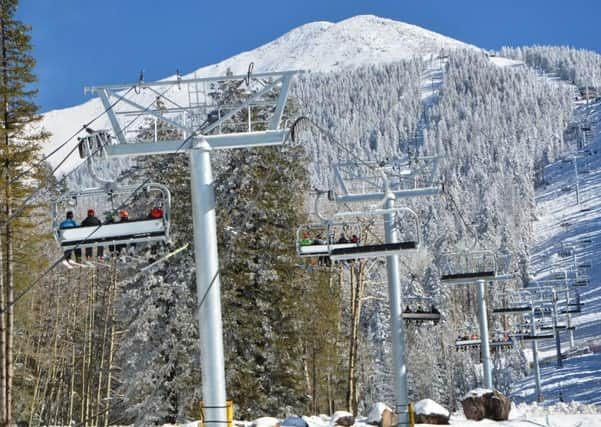Travel review: Arizona - forever a liberal enclave


By the time Donald Trump leaves the White House a small contraction in overseas tourism may be the least of the country’s worries. However, amid fears over the building of that wall, his out of control Twitter feed and a less than diplomatic approach to North Korean relations, according to Forbes international visitors to the US have slumped by 1.4 per cent since the start of the year and the blame is being laid at the POTUS’s door.
For those considering striking America from their bucket list, don’t. In a sea of red, there are still pockets of blue worth exploring and right up there is Flagstaff. Ranked as the third most liberal city in Arizona, ambling around downtown amid the hipster microbrewery bars, vintage clothes shops and independent bookshops, it is possible just for a moment to imagine that the last 12 months have all been a terrible dream.
Advertisement
Hide AdAdvertisement
Hide AdLike its near neighbour Williams, Flagstaff is an overnight stop for the steady stream of solo tourists and coach parties heading to the Grand Canyon. It’s an hour and a half drive to the south rim of one of America’s most famous natural phenomenons and, to see the best of it, fight your way through the parking lot and the packed viewing platform and head down one of the trails where the crowds quickly thin out.
Once the inevitable selfies have been taken at the Grand Canyon, most move on, but Flagstaff and the surrounding area is worth a few more days of your time. It’s laid-back vibe is largely due to the fact it’s also home to a large university and lies on Route 66, that most iconic of US road trips.
While even in the autumn the likes of LA and Las Vegas can be uncomfortably hot, the added bonus of Flagstaff is that it actually has weather. Proper weather. So while summers bask in the high 70s, by October it drops to the low 60s and come December the snow starts to fall.
Overlooked by the impressive San Francisco Peaks, this is an outdoorsy type of place and to get a flavour of the area head to the Arizona Snowbowl just a few miles from downtown.
Advertisement
Hide AdAdvertisement
Hide AdUntil a couple of years ago it was little more than a modest winter ski resort. The transformation began when they were finally awarded the right to make their own snow. It’s a controversial business. The application was opposed by Native Americans who claimed that the use of reclaimed sewage water to make the snow was an affront to their ancient tribal lands.
The protests rumbled on, but in 2014 the city of Flagstaff approved a 20-year deal to sell reclaimed water to the Snowbowl and, with guaranteed snow, it has opened the door for millions of pounds worth of investment to cater for both advanced skiers and beginners.
Outside of the ski season though it is still possible to ride the main chairlift car. It takes about half an hour to climb to 11,500ft and the summit offers an impressive bird’s eye views across this part of the Colorado Plateau.
On the road back to Flagstaff, it’s worth stopping off at the Museum of Northern Arizona. Founded in 1928 to protect and preserve the natural and cultural heritage of northern Arizona, it’s a pretty succinct guide to the various tribes from the Hopi to the Navajo and Zuni who still call this place home.
Advertisement
Hide AdAdvertisement
Hide AdThe archives over the road also do private tours if you book in advance, which is worth it alone to see some of the Native American tribal art and carvings up close.
Even an hour of so in the museum and archive is enough to put paid to that old misconception that the US doesn’t do history. While most of the small towns can trace their roots to the 20th century the country did have a past before Christopher Columbus rolled up.
Close to Flagstaff are a number of impressive National Monuments that shed even further light on Arizona’s ancient tribal past and it’s easy to take in two or three in a day. The Wupatki National Monument is probably the most varied and his home to five large ruined pueblos, all of which are easily viewable on short trails.
From there head to Montezuma Castle, which is small but spectacular. The beautifully preserved five-floor structure, occupied between AD 1100 and 1425, was built high above ground in an alcove in the limestone cliffs and the original layout is still clearly visible.
Advertisement
Hide AdAdvertisement
Hide AdMore impressive still is Walnut Canyon. A one and a half mile trail leads down into the canyon, passing the various cliff dwellings once home to Sinagua tribe from about AD 1100 to 1250. No one knows quite how they survived in this arid part of Arizona, but survive they did.
Right now, America might be going through interesting times, but standing amid these ancient ruins is a reminder that no one can stop the passage of time and eventually even Trump will be just a footnote in history.
GETTING THERE
Sarah stayed at the Radisson Inn Marriott in Flagstaff (marriott.com)
For more information about visiting Arizona go to visitarizona.com
Advertisement
Hide AdAdvertisement
Hide AdSarah visited Arizona on a road trip which began and ended in Los Angeles. A week’s car hire from LAX costs from £148, based on travel in February 2018, and Hertz also operates from Phoenix airport. www.hertz.co.uk/p/american-road-trip-planner